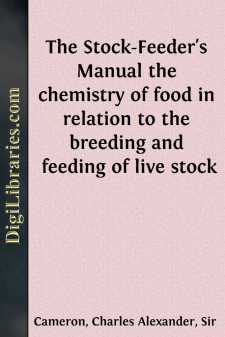Categories
- Antiques & Collectibles 13
- Architecture 36
- Art 48
- Bibles 22
- Biography & Autobiography 813
- Body, Mind & Spirit 142
- Business & Economics 28
- Children's Books 14
- Children's Fiction 11
- Computers 4
- Cooking 94
- Crafts & Hobbies 4
- Drama 346
- Education 46
- Family & Relationships 57
- Fiction 11828
- Games 19
- Gardening 17
- Health & Fitness 34
- History 1377
- House & Home 1
- Humor 147
- Juvenile Fiction 1873
- Juvenile Nonfiction 202
- Language Arts & Disciplines 88
- Law 16
- Literary Collections 686
- Literary Criticism 179
- Mathematics 13
- Medical 41
- Music 40
- Nature 179
- Non-Classifiable 1768
- Performing Arts 7
- Periodicals 1453
- Philosophy 64
- Photography 2
- Poetry 896
- Political Science 203
- Psychology 42
- Reference 154
- Religion 513
- Science 126
- Self-Help 84
- Social Science 81
- Sports & Recreation 34
- Study Aids 3
- Technology & Engineering 59
- Transportation 23
- Travel 463
- True Crime 29
The Stock-Feeder's Manual the chemistry of food in relation to the breeding and feeding of live stock
Categories:
Description:
Excerpt
The
CHEMISTRY OF FOOD.
When Virgil composed his immortal "Bucolics," and Varro indited his profound Essays on Agriculture, the inhabitants of the British Islands were almost completely ignorant of the art of cultivating the soil. The rude spoils torn from the carcasses of savage animals protected the bodies of their hardly less savage victors; and the produce of the chase served almost exclusively to nourish the hardy frames of the ancient Celtic hunters. In early ages wild beasts abounded in the numerous and extensive forests of Britain and Ireland; but men were few, for the conditions under which the maintenance of a dense population is possible did not then exist. As civilisation progressed, men rapidly multiplied, and the demand for food increased. The pursuit of game became merely the pastime of the rich; and tame sheep and oxen furnished meat to the lowly as well as to the great. Nor were the fruits of the earth neglected; for during the latter days of the dominion of the Romans, England raised large quantities of corn. Gradually the food of the people, which at first was almost purely animal, became chiefly vegetable. The shepherds, who had supplanted the hunters, became less numerous than the tillers of land; and the era of tillage husbandry began.
At present the great mass of the rural population of these countries subsist almost exclusively upon vegetable aliment—a diet which poverty, and not inclination, prescribes for them. Were the flesh of animals the staple food of the British peasantry, their numbers would not be nearly so large as they now are, for a given area of land is capable of sustaining a far larger number of vegetarians than of meat eaters. The Chinese are by no means averse to animal food, but they are so numerous, that they are in general obliged to content themselves on a purely vegetable diet.
In the manufacturing districts of Great Britain, there are several millions of people whose condition in relation to food is somewhat different from that of the small farmer and agricultural laborer. The artizans employed in our great industries are comparatively well paid for their toil; and the results of their labor place within their reach a fair share of animal food. This section of the population is rapidly increasing, and consequently is daily augmenting the demand for meat. The rural population is certainly not increasing; rather the reverse. Less manual labor is now expended in the operations of agriculture, and even horses are retiring before the advance of the steam plough. The only great purely vegetable-feeding class is diminishing, and the upper, the middle, and the artizan classes—the beef and mutton eating sections of society—are rapidly increasing. It is clear, then, that we are threatened with a revival of the pastoral age, and that in one way, at least, we are returning to the condition of our ancestors, whose staple food consisted of beef, mutton, and pork.
And here two questions arise....


